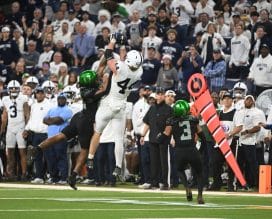Flyers
Around the NHL: the Contenders, the Tweeners, and the Forgettables
By Ryan Black, Sports Talk Philly staff writer
As we all come down from the glow of the holidays and enter the doldrums of real, actual, cold, boring winter, the hockey season holds different possibilities for everyone.
Some fans will be looking forward to their teams staying the course, adding assets, and jockeying for home ice advantage. Fans of another set of few teams will be biting their fingernails and hoping to hold onto a wild card berth or sneak into one with a solid second half. And the rest of us — and yes, the Flyers are firmly in this category — will be hoping for the best draft pick and trade deadline value while avoiding outright embarrassment.
It hasn’t gone as we may have hoped, but the show goes on. Let’s look at where the teams fall as 2019 enters either the second half of the season.
The Contenders:
There’s some clear-cut great teams in the NHL right now. In most seasons, we’d be having a tight debate over who the best team in the league is at this point. Would it be the Washington Capitals, the defending champs who lead the Metropolitan at 25-12-4? Or the Pittsburgh Penguins, winners of the two Cups before them, who have recovered from a slow start to win an eye-popping eight of nine to reach 23-12-6?
Perhaps the high-scoring Toronto Maple Leafs at 27-12-2, the rock-solid Winnipeg Jets at 26-13-2, the always-dangerous Nashville Predators at 25-15-3? Hell, the Calgary Flames are impressive with a 26-13-4 first half, leading the still-magical Vegas Golden Knights (26-15-4) for tops in the Pacific Division.
It’s none of those teams, though, and it’s not even close.
The Tampa Bay Lightning seem to be emerging as the NHL’s answer to an NBA superteam. They’re an obscene 32-8-2 through 42 games, for 66 points, 10 more than anyone else has at this juncture. Before this weekend, that league-wide lead was 12 points through 41 games, the largest gap any team has held since 1956.
They’ve scored 23 goals more than the nearest competition, have a +52 goal differential, and three scorers in the top 20, including league leader Nikita Kucherov, who has 69 points — a pace for something in the mid 130s. This team is rolling with no end in sight, and is perhaps the clearest favorite the league has seen decades.
The Tweeners:
The middle category encompasses both teams in playoff position that don’t seem to be legitimate championship threats, and teams just outside who have a shot at squeezing in.
Currently, the Boston Bruins and Columbus Blue Jackets hold the third spots in the Atlantic and Metropolitan Divisions, respectively. The Bruins are a very good team that has been ravaged by injuries, and is perhaps better than their 24-14-4 record — they just have the misfortune of sharing a division with Toronto and Tampa. Despite having only a three point advantage on the Montreal Canadiens, the closest team currently on the outside, the Bruins seem safe.
The Blue Jackets, at 24-14-3, seem more volatile. Though they are a good and cohesive team, their coach, John Tortorella, is prone to outbursts and mood swings — just this week, he called his whole squad “part-timers” after a sloppy loss. That sometimes-aggravating style combines with uncertainty around the team’s two biggest stars: Artemi Panarin and Sergei Bobrovsky, who both seem headed to unrestricted free agency this summer. Though the team’s early success has quelled some potential trade talk, any brief losing streak would place the team on the outside looking in–and turn the speculation about their futures up to fever pitch.
In the Eastern wild card spots sit the resurgent Buffalo Sabres and the surprisingly competent New York Islanders. The Sabres benefit from numerous young prospects emerging into very good NHL players, while the underpowered Islanders have managed to float on defense, allowing the fewest goals against thanks to Barry Trotz’s smart, stifling system. An inconsistent Montreal Canadiens team sits just a point behind those two. After that, the Carolina Hurricanes might be the only team left in the East with an outside shot at the dance-though they’re 6 points behind pace.
Out West, the picture is hazier. The San Jose Sharks, shiny new Erik Karlsson included, have not been nearly the threat some predicted before the year, but they’re still solidly a playoff team with 53 points, third in the Pacific. The Colorado Avalanche have two of the league’s three top scorers in Mikko Rantanen (65 points) and Nathan MacKinnon (63 points) and yet have only compiled a 20-14-8 record, good for 48 points and third in the Central.
But the Avalanche benefit from a weak conference. They’re technically tied with the Dallas Stars, who actually have more wins (22-17-4) but have played more games and thus slot into the first wild card. Speaking of volatile, the Stars this year are the definition. Last week, their two stars Jamie Benn and Tyler Seguin were publicly excoriated by the team’s CEO for their “terrible” play. That’s worth watching going forward.
From there, it’s all mediocrity. The painfully low-scoring Anaheim Ducks somehow hold the last wild card spot with 45 points, trailed closely by a young Vancouver Canucks team that just saw its hot-shot rookie and Calder trophy favorite Elias Petterssen go down to a MCL sprain.
A milquetoast Minnesota Wild team are still in the running with 43 points, and I’ll begrudgingly put the Edmonton Oilers on this list at 41 points. The Alberta also-rans took off briefly after firing head coach Todd McLellan and replacing him with Ken Hitchcock, and then promptly fell off the face of the earth again, going 2-7-1 in their last 10. With Connor McDavid, though, they’re not completely out of the picture.
The Forgettables:
The Los Angeles Kings (17-23-3; 37 points), Chicago Blackhawks (15-21-7; 37 points), and St. Louis Blues (16-19-4; 36 points) were once the toast of the Western Conference. Now, they’re all bad veteran teams with bloated payrolls and a lot of selling to look forward to. The Arizona Coyotes (18-21-3; 39 points) remain a bleak and mostly-irrelevant team with the third-fewest goals scored in the league and few recognizable NHL names on their roster.
In the East, there’s more of the same. The Florida Panthers (17-16-7; 41 points), New York Rangers (17-17-7; 41 points), and New Jersey Devils (16-18-7; 39 points) are all completely pedestrian, but just stable and deep enough to threaten neither a wild card push nor a lottery pick. The Detroit Red Wings are a step behind, but would probably benefit most by selling off pieces like veteran goaltender Jimmy Howard: the once-perennial contenders now have little high-end talent in the pipeline and little to speak of on the big club, and need to look ahead.
The Ottawa Senators are precisely the fiasco that their entire last two years have ensured they’d be: An unsteady ship with a demoralized team and an uncertain future, dead last in the league and allowing a league high four goals per game.
And one point ahead of them at the league floor? Well, that’d be the Philadelphia Flyers. So, um, E-A-G-L…





